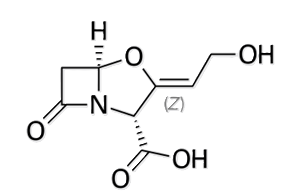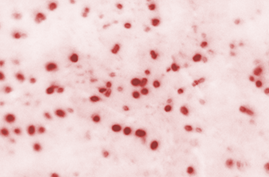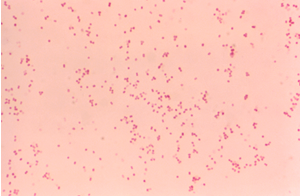Medical Pharmacology Chapter 35 Antibacterial Drugs
Penicillins And Others
Beta-lactamase inhibitors
 |
Mechanism of Action
Clavulanic acid is the prototype "suicide inhibitor" derived from Streptomyces clavuligerus.
Clavulanate is then is suicide substrate for many class A beta-lactamases, binding to the enzyme's active site then hydrolyzed the former reactive intermediate which covalently inactivates the enzyme.
As result of this inactivation, the beta-lactamase is prevented from destroying co-administered penicillins or cephalosporins.
Clavulanic acid itself exhibits very limited intrinsic antibacterial activity, but in combination it extends coverage of companion antibiotics to beta-lactamase producing strains.
Some beta-lactamases like AmpC beta-lactamases (cephalosporinases associated with many of the Enterobacteriaceae) are not well inhibited by clavulanate.2
Pharmacokinetics
Clavulanate is co-formulated most commonly with amoxicillin.
Clavulanateis well absorbed orally (especially when taken at the start of a meal) and reaches peak levels usually within 1–2 hours.
The drug half-life is ~1 hour, similar to amoxicillin.3,4
Clavulanate is distributed into tissues such as lung, middle ear fluid, sinuses, and urine, achieving therapeutic concentrations in these sites.5
The drug combination (amoxicillin/clavulanate)6 undergoes partial hepatic metabolism; a significant fraction (25%-40%) is eliminated unchanged renally5, and dose adjustments are recommended in severe renal dysfunction.6 Current amoxicillin/clavulanic acid formulations use a 4:1 amoxicillin-to-clavulanate ratio.6
Therapeutic Uses
The addition of clavulanic acid to amoxicillin broadens the spectrum by including many ß-lactamase-producing bacteria.
The amoxicillin-clavulanate combination is appropriate for many community-acquired infections, including:
Respiratory Tract Infections
Infections include otitis media, sinusitis, bronchitis, and pneumonia.
Causative organisms include H. influenzae or Moraxella catarrhalis producing ß-lactamase.1,6
 |
 |
|
|
Skin and Tissue Infections
Examples could include infected animal/human bites as well as diabetic foot infections.
These concerns apply when staphylococci and anaerobes might be present.1
Urinary Tract Infections
Here the concern centers on those infections resulting from Enterobactericeae including some Extended-Spectrum-Beta-Lactamase (ESBL)-Producing strains under circumstances in which alternative drugs would not be suitable.7
Enterobactericeae include any number of Gram-negative bacteria including: Klebsiella, Citrobacter, Enterobacter, Salmonella, Escherichia coli, Proteus, Serratia and others.
Enterobacteriaceae are part of normal gut bacteria.
However they also represented common cause of urinary tract infections with some species responsible for diarrhea.
Life-threatening complications may be associated with spread to the bloodstream.
Enterobacteriaceae may develop antibacterial resistance including resistance to carbapenem groups of antibiotics.
That is, Enterobactericeae may be producing carbapenemase.9
Dental Infections and Bite Wound Prophylaxis/Treatment
The rationale here has to do with the activity of amoxicillin/clavulanate combination against oral anaerobes.8
August, 2025
|
|
This Web-based pharmacology and disease-based integrated teaching site is based on reference materials, that are believed reliable and consistent with standards accepted at the time of development. Possibility of human error and on-going research and development in medical sciences do not allow assurance that the information contained herein is in every respect accurate or complete. Users should confirm the information contained herein with other sources. This site should only be considered as a teaching aid for undergraduate and graduate biomedical education and is intended only as a teaching site. Information contained here should not be used for patient management and should not be used as a substitute for consultation with practicing medical professionals. Users of this website should check the product information sheet included in the package of any drug they plan to administer to be certain that the information contained in this site is accurate and that changes have not been made in the recommended dose or in the contraindications for administration. Advertisements that appear on this site are not reviewed for content accuracy and it is the responsibility of users of this website to make individual assessments concerning this information. Medical or other information thus obtained should not be used as a substitute for consultation with practicing medical or scientific or other professionals. |